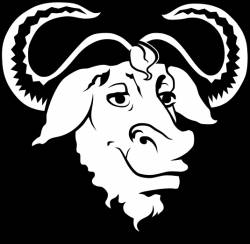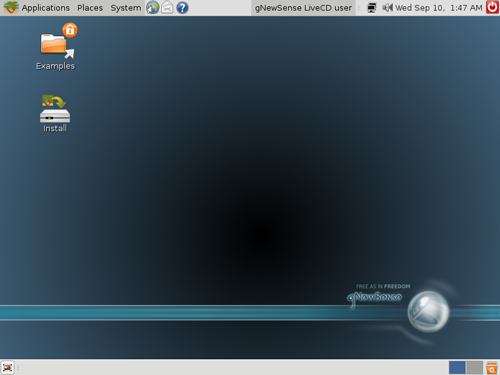In the fall of 2003, Jeffrey Beaupre was a 26 year old full-time Computer Engineering and Computer Science student at the University of Southern California. An 11th grade high school drop out, Jeffrey turned his life around at the age of 21 after developing a personal relationship with Jesus Christ. With his B.S. at USC, Jeffrey intends to work on defense contracts and continue his education as a Trojan.
The world of computing is a constantly evolving model of technological innovation, financial gain and ruin, and philosophical ideals. The open source revolution has placed these three branches of the industry in the spotlight, shaking the traditional foundations of the technology market. In a world of secrecy, and even deception, some programmers are taking a stand to keep information free. These programmers have created new methods of software licensing to ensure their work will never be hidden from those willing to promote the spread of ideas, designs, and quality of product. The educational, financial, and moral outcome of this movement has impacted the lives of millions of people, many many unaware of the ideas reshaping the world around them. This article is intended to open the public eye to the repercussions and free (open source) software movement.
Imagine for a moment that you had single handedly discovered a cure for cancer. Imagine further that during your search for the cure, you had befriended many cancer patients, perhaps even members of your own family. Immediately you start distributing this cure to your friends and family. Your sense of humanity is so great that you even make your product available to anyone who wants it, asking only compensation for the cost of manufacturing the drug. Then, along comes a large pharmaceutical company with an eye for profit. They want to sell your cure and make a vast fortune. They find out that you are giving this drug away free, acquire a sample, reverse engineer the formula, and legally patent it. The next day all the people you have helped, along with your friends and family, are served with a cease and desist order stating that they must buy this patented formula from the rightful owner. The insult to injury comes when you are diagnosed with cancer, and are required to pay this large company an exorbitant fee for the cure you invented.
“Hogwash,” you might say. Well, the scenario presented may appear a bit contrived, but this is exactly what was happening to software engineers who wanted to freely share the computer code they had written with other developers. The stakes may not have been as high as the cure for cancer, but the principle was the same. Today open source software makes high speed internet widely available at a considerably reduced cost. It empowers a wide range of technologies from personal computing to NASA space exploration. If not for an innovative approach to protect this “free” software, the cures for our technological ailments might have been patented and stolen exactly like the hypothetical cure for cancer.
This innovative means to protect the “freedom of information” is known as the GPL (General Public License). The GPL is a way for software developers to protect the code they write from being stolen and patented by anyone else, while still ensuring its free and public use.
A GNU Way of Thinking
So, what is GNU? GNU (pronounced “guh-new”) is a recursive acronym: GNU (see Fig. 1) is Not Unix. It is a collection of “open source” software in the form of an operating system, commonly known as Linux. The complete name is actually GNU/Linux (www.gnu.org). An operating system is the fundamental software that makes a computer useful. Without an operating system a computer cannot run programs, access networks (like the internet), or use most hardware generally taken for granted, i.e. printers, sound cards, or video cards. “Open source” is a loose term for any piece of software whose code is freely available to be read, used, modified, and distributed. Any software protected by the GPL is, by definition, open source software. But, open source software is not limited to programs protected by the GPL. It may be protected by other licenses that provide similar protections or no license at all.
GPL – The Protection of the “Copyleft”
The GPL is often referred to as a “copyleft license” (as opposed to copyright) because of the nature of the protections it offers. Essentially, any software protected by the GPL has the following freedoms:
- Anyone may copy and distribute the software freely.
- Anyone may modify and distribute modified copies of the program so long as the files are identified as modified.
- A distribution fee may be charged by anyone distributing GPL protected code.
- Any new programs based on or including GPL protected code must also be under the same protections as the GPL and offer the same freedoms.
- Once code is protected by the GPL it can never be outside the protections of the license.
- All GPL code is offered without warranty. Warranties may be offered by individuals distributing GPL code but only as a separate agreement outside of this license. The authors of the code are never responsible for anything the code might be used for or any undesirable outcomes encountered by using the code.
These are highlights from the actual protections afforded by the GPL. The exact protections afforded by the GPL can be found at www.gnu.org
“Free as in Freedom”
One of the most interesting aspects of open source software is that you can make money with it. “Free software” has much more to do with rights than cost. The GNU philosophy puts it this way, ‘Free software’ is a matter of liberty, not price. To understand the concept, you should think of ‘free’ as in ‘free speech,’ not as in ‘free beer’ [1]. There are, in fact, several ways to make money from “free software.”
The easiest way is to charge for distribution. Distribution can be in the form of CD ROMs, internet downloads, or preinstalled software on a new computer. Another common way to make money on “free software” is to provide documentation and/or technical support for a nominal fee. A third way is to sell warranties for the free software. Each method may be employed by the original author of the software or anyone who receives a copy of the free software. Moreover, these freedoms are afforded, and protected, by the GPL.
Birth of a Revolution
Open source software, GNU/Linux (see Fig. 2 for an example of a GNU/LINUX distribution), the GPL, and similar licenses and projects all arose at roughly the same time for very similar same reasons. It all started with a phenomenal operating system called UNIX. UNIX was, and still is, one of the most powerful network operating systems ever developed. A network operating system is one that specializes in offering services on a network. These services can include providing internet and email access for your PC, making web pages available on the internet, and managing domain names (like usc.edu and mypage.com) to name just a few. The problem, however, was twofold. Number one, UNIX can be extremely expensive. A single copy of UNIX complete with documentation can easily cost as much as $10,000. Problem number two lies in the proprietary nature of UNIX. Prior to the open source revolution, UNIX was sold only by large corporations such as IBM who meticulously protected the code behind their powerful programming. Thus, savvy developers who enjoy working with operating systems could not use UNIX without paying a small fortune for a copy. Furthermore, even with a copy, they could not modify or delve into the finer intricacies of the code, as access to the source code was limited to its proprietary creators.
It is not clear what the first open source project was, but in 1991 open source programmers began to rally behind a young programmer named Linus Torvalds and his new project called Linux. At the time Linus was a university student in Finland, and had no idea that his pet project would in a few years be a mover and shaker in the global software market. In 1999, over 12,000 people attended the first World Linux Expo. At that time an estimated 10 million people were using Linux worldwide, and the number continues to grow [2].
Who Cares?
So, why should the rest of the world care about a bunch of geeky guys plugging away at their computers into the wee hours of the morning, especially if they are making their work freely available? Corporations today cannot survive without high speed internet access. Small local ISPs (Internet Service Providers) offer competitive rates on high speed internet connections for businesses. Without this competition it is very likely that both corporate and consumer high speed internet access would be much more expensive than it is today. The reason these local ISPs can start up and survive is largely due to open source network operating systems such as GNU/Linux and BSD (Berkley Standard Distribution). This software also makes it possible for large ISPs to expand and offer large scale systems at prices drastically lower than their traditional UNIX counterparts. These savings apply to business clients, and thus end up affecting prices at the consumer level.
This also impacts large corporations who need to share data amongst various offices and branches within the company. The “Trusted Solaris 8 Data Center Server Software License Standard Edition & Limited Documentation, SPARC Platform Edition,” an operating system made by Sun Microsystems to deliver secure data in both high capacity and high speed, sells for $58,495.00 for the software alone (as listed on Sun Microsystems Online Store). This is an extremely high end product, but its equivalent function can be attainted with open source software and a good system administrator.
So it will save the big guys money, let small businesses enter a competitive marketplace, and might even save consumers some money in the end. But, does open source software directly affect the guy on the street? The answer to that question is “not yet.” New open source applications are becoming more and more popular. Take, for example, Open Office, a free product competing with Microsoft Office. This office suite is so powerful that Sun Microsystems has used it as the basis for their own “office” suite, Star Office. Linux is constantly being developed and refined as a desktop operating system as well as a server platform. That means that instead of paying $269.99 for Microsoft Windows XP or $412.99 for Microsoft Office 2003 the guy on the street may save hundreds of dollars when he buys a new computer. Moreover, he will also have the latest updated application software without having to delve deep into his pockets. This is a significant change from the cost-based upgrades consumers are accustomed to in the home and even business PC market.
The Battle Rages On
Large companies like Microsoft aren’t about to lie down while free software dissolves their profit margin. Microsoft is striking back by incorporating DRM into their latest version of MS Office 2003. DRM stands for Digital Rights Management. It is a form of encryption to protect the Microsoft format of office documents. This is a bombshell to the open source community. Staying compatible with main stream software like MS Office is fundamental to its wide spread success. It probably would not be difficult to reverse engineer Microsoft’s DRM encryption, thus enabling free software to create and open Office 2003 documents, but doing so would be in violation of the Digital Millennium Copyright Act (DMCA), which prohibits “circumvention of technological measures used by copyright owners to protect their works or tampering with copyright management information” [3]. Implementing this type of protection on all documents created by MS Office is a shrewd move by Microsoft, but shrewd moves are partly what have made the company such a success. This will, no doubt, set precedence for other companies who are fighting against the open source movement, and may lead to future problems of a similar nature for engineers trying to keep their software both free and useful.
If You Can’t Beat ‘Em, Join ‘Em
Not all large corporations are against the open source movement. In fact, many are embracing it. When Apple released OSX they stunned the computing world by basing their latest product on a very popular and powerful open source kernel. A kernel is the core piece of the operating system upon which everything else is built. It “is the one program running at all times on the computer, with all else being application programs”? [4]. When Apple decided to base their kernel on the BSD project, most people thought they couldn’t have made a better choice. They got the power of UNIX and the support of thousands of programmers working on the open source project; moreover, they got it for free. Apple did have to make some changes to the system to accommodate their hardware, but they abided by the open source rules and kept “Darwin,” their new kernel, open source. Apple still manages to make a huge profit on this product, not by selling the kernel, but by selling their extremely popular graphical user interface (GUI) and application programs that complete the system.
Choosing Quality
IBM has embraced the open source revolution in the form of Linux. As mentioned earlier, GNU/Linux is a powerful, free UNIX-like operating system. IBM describes it as a “stable, secure, scalable and powerful” system that is “is one of the cornerstones of the on-demand operating environment” [5]. High praise from such a distinguished company in the computing world cannot go unnoticed. IBM has combined the clustering power of Linux (combining many individual computers to act as a single supercomputer) with its own outstanding hardware to produce some of the highest quality supercomputers in the world. These supercomputers are used everyday in research facilities, government institutions, and corporations worldwide. For IBM, open source means more than saving money; it means using the best tool for the job.
Sun Microsystems has a huge stake in the operating systems market, but only so far as it benefits the hardware they sell. Their high performance workstations and servers are extremely proprietary in nature. They have been making specialized operating systems to manage their hardware for years. Recently, however, Sun has begun to incorporate Linux into their computing solutions. Sun even offers its own version of Linux alongside Solaris, the operating system they developed. Like IBM, Sun has used the powerful clustering ability of Linux, in conjunction with Oracle, to make one of the most powerful data servers available.
Taking the Next Step
The open source revolution is not only affecting the computer industry and the internet, it is also opening doors for many scientific and commercial projects. NASA is using Linux in countless projects ranging from x-ray telescopes, to robots, to Mars rovers. Linux is being used in car stereos, mp3 players, and state-of-the-art video players. After 9-11 security agencies used Linux-based systems to develop security models for our airports. Because they are scalable, powerful, and easily modified, open source solutions may soon be powering our cars and household appliances, and touching every aspect of our lives. But, if you ask any open source programmer, they will tell you that amazing outcomes and powerful economic solutions are a secondary issue to the open source movement. They will tell you that it is all about freedom: freedom to share ideas and use them in ways unimagined. It was this desire for freedom that inspired the open source movement, materialized the General Public License, and is now empowering engineers to do what they do best: solve problems.
References
-
- [1] “GNU Philosophy.” Internet: http://www.gnu.org/philosophy/free-sw.html, [Nov. 4, 2003].
- [2] M. Welsh et al. Running Linux, 3rd Edition. California, 1999, pp. 4.
- [3] Library of Congress. “The Digital Millennium Copyright Act.” Internet: http://www.loc.gov/copyright/legislation/dmca.pdf, [Nov. 4, 2003].
- [4] A. Silberschatz et al. Operating System Concepts. New York, 2003, pp. 6.
- [5] IBM. Internet: http://www-1.ibm.com/linux/, [Nov. 4, 2003].
- [6] “GNU Licenses.” Internet: http://www.gnu.org/licenses/licenses.html, [Nov. 4, 2003].
- [7] Sun Microsystems. Internet: http://store.sun.com/catalog/doc/BrowsePage.jhtml;ZAMTHLUST5UBSM3OSKXO?cid=57765&parentId=52196>. 4 Nov. 2003.
- [8] Amazon. “Windows XP.” Internet: http://www.amazon.com/exec/obidos/tg/detail/-/B00005MOTH/qid=1068085671/sr=1-1/ref=sr_1_1_etk-software/002-0481316-5732865?v=glance&s=software&n=229534, [Nov. 4, 2003].
- [9] Amazon. “MS Office 2003.” Internet: http://www.amazon.com/exec/obidos/tg/detail/-/B0000AZJVC/qid=1067912412/sr=1-3/ref=sr_1_3_etk-software/104-7917306-8294312?v=glance&s=software&n=229534, [Nov. 4, 2003].
- [10] GNU. Internet: http://www.gnu.org, [Nov. 4, 2003].






